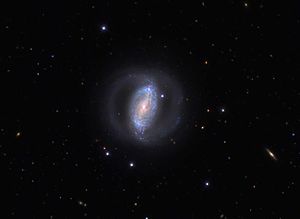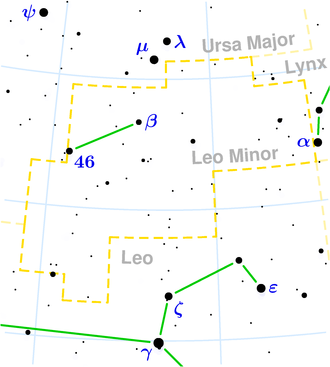NGC 3504
| Galaxy NGC 3504 |
|
|---|---|

|
|
| Image taken with the 81 cm reflecting telescope of the Mount Lemmon Observatory | |
| AladinLite | |
| Constellation | Little lion |
|
Position equinox : J2000.0 , epoch : J2000.0 |
|
| Right ascension | 11 h 03 m 11.2 s |
| declination | + 27 ° 58 ′ 21 ″ |
| Appearance | |
| Morphological type | (R) SAB (s) from / HII / LINER |
| Brightness (visual) | 10.9 likes |
| Brightness (B-band) | 11.7 mag |
| Angular expansion | 2.7 ′ × 2.1 ′ |
| Position angle | 159 ° |
| Surface brightness | 12.6 mag / arcmin² |
| Physical data | |
| Affiliation | Abell 1185 NGC 3504 Group Leo II Group LGG 227 |
| Redshift | 0.005117 ± 0.000007 |
| Radial velocity | (1534 ± 2) km / s |
|
Stroke distance v rad / H 0 |
(67 ± 5) · 10 6 ly (20.4 ± 1.4) Mpc |
| diameter | 65,000 ly |
| history | |
| discovery | Wilhelm Herschel |
| Discovery date | April 11, 1785 |
| Catalog names | |
| NGC 3504 • UGC 6118 • PGC 33371 • CGCG 155-049 • MCG + 05-26-039 • IRAS 11004 + 2814 • KUG 1100 + 282 • 2MASX J11031119 + 2758207 • GC 2287 • H I 88 • h 810 • GALEX ASC J110311 .35 + 275819.8 • LDCE 763 NED006 | |
NGC 3504 is an active bar-spiral galaxy with extensive star formation regions of the Hubble type SBab in the constellation Leo Minor in the northern sky. It is estimated to be 67 million light-years away from the Milky Way and has a diameter of about 55,000 ly.
In the same area of the sky there are u. a. the galaxies NGC 3493 , NGC 3510 , NGC 3512 , NGC 3515 .
The supernovae SN 1998cf and SN 2001ac (Type-IIn?) Were observed here.
The object was discovered by Wilhelm Herschel on April 11, 1785 .
